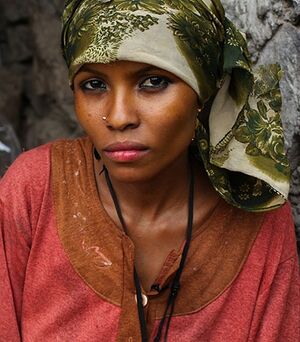Elamite people: Difference between revisions
| Line 40: | Line 40: | ||
===Cuisine=== | ===Cuisine=== | ||
=== | ===Dress=== | ||
[[File:Elam traditional costume.jpeg|200px|thumb|right|An Elamite girl in traditional costume circa 1908]] | |||
====Islamic dress==== | |||
In spite of the long and well-established presence of Islam in Elam, headscarves and veils were historically uncommon in Elam. A formal ban on all Islamic veils (including headscarves, chador, and burqas) existed from 1941 to 1980. Hijab surged in popularity during the 1980s following Islamist revolutions in neighbouring countries, particularly the {{wpl|Iranian Revolution|1979 Revolution in Iran}}, prompting the government to rescind their anti-veiling policies out of fear of a similar revolutionary backlash. For a brief period from 1996 to 2002, headscarves were compulsory for women over the age of 9, a policy which was also rescinded due to controversy and popular backlash. | |||
==Diaspora== | ==Diaspora== | ||
Revision as of 19:45, 15 April 2019
Haltama عيلاميون | |
|---|---|
 An Elamite woman from Susa | |
| Total population | |
| c. 3 Million (2015) | |
| Regions with significant populations | |
| Elam | 2,402,610 |
| Languages | |
| Elamite, Arabic | |
| Religion | |
| Shia Islam (Twelver Jafarites) | |
The Elamites (Elamite: Haltama; Arabic: عيلاميون) are an ethnic group of about 3 million people, with the vast majority found in Elam and near its borders. They are a small minority group in Iran, where they are also native, but they are also found through their diaspora throughout the middle east. The Elamites are almost entirely Shia Muslims. Culturally, linguistically, and genetically, the Elamites are distinct from their Semitic and Indo-Iranian neighbours. Although most Elamites speak the Elamite language predominantly, many are bilingual in both Elamite and either Arabic or Persian, and a small minority are monolingual Arabic speakers.
History
Origins
Genetics
Culture
Language
Religion
Cuisine
Dress
Islamic dress
In spite of the long and well-established presence of Islam in Elam, headscarves and veils were historically uncommon in Elam. A formal ban on all Islamic veils (including headscarves, chador, and burqas) existed from 1941 to 1980. Hijab surged in popularity during the 1980s following Islamist revolutions in neighbouring countries, particularly the 1979 Revolution in Iran, prompting the government to rescind their anti-veiling policies out of fear of a similar revolutionary backlash. For a brief period from 1996 to 2002, headscarves were compulsory for women over the age of 9, a policy which was also rescinded due to controversy and popular backlash.
